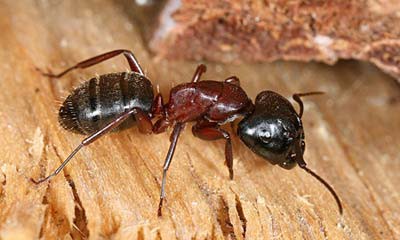Abstract
Do ants sometimes ruin your picnic? There are some chemical ant repellents you can spray to keep them away, but who wants to spray poison all over their food? In this science project you can investigate some less toxic solutions that may be around your home so that your next picnic will not become an ant buffet!Summary
Sara Agee, Ph.D., Science Buddies
- Dixie® is a registered trademark of Georgia-Pacific LLC. All rights reserved.
- Q-tips® is a trademark of Unilever United States, Inc.

Objective
Test several household and natural solutions for their effectiveness as an ant repellent.
Introduction
All animals can sense chemical signals in their environment. Some animals even use chemical signals to communicate. One animal famous for chemical communication is the ant, like the one shown in Figure 1, below. When you see a trail of ants, it is because they are following an invisible chemical trail. This type of chemical signal is positive, and it is called an attractant because it is meant to attract others towards the signal. Other times a signal may be negative, telling others to stay away. This type of signal is called a repellent.

Figure 1. This ant is specifically a carpenter ant. Carpenter ants (which belong to the genus Camponotus) are commonly found in the United States. (Image credits: Richard Bartz, 2007)
Sometimes repellents can come in handy. We do not like ants to get into our home, so if we can apply a negative chemical signal around our foundation, the negative chemical signal will tell the ants to stay away. Chemical companies will sometimes try to copy a negative chemical signal to sell as an insect repellent. But sometimes these chemicals can have undesirable side effects, or be poisonous to pets or small children. Are there other, more natural and less toxic remedies?
In this science project, you will test different solutions from around your home for their usefulness as an ant repellent. You will use a simple circle test to find out if a substance is a repellent or not. After testing different solutions, perhaps you can find a home remedy that is safer for your family than a commercial repellent product.
Terms and Concepts
- Chemical signals
- Attractants
- Repellents
Questions
- What is a repellent?
- What is an attractant?
- Will repellents or attractants act as a chemical barrier for ants?
Bibliography
Have an adult help you do further research by visiting the following websites, which give information about ants and ant repellents:
- National Park Service. (2003, December 18). Integrated Pest Management Manual: Ants. Retrieved June 26, 2012.
- The Best Control 2: Encyclopedia of Integrated Pest Management. (n.d.). Nontoxic Ant Control. Retrieved June 26, 2012.
This project was inspired by two projects from the California State Science Fair that investigate natural sources of ant repellent:
- Ross, M. (2006). California State Science Fair 2006 Project Summary: Ants and Plants. California State Science Fair. Retrieved June 26, 2012.
- Shu, C.V. (2006). California State Science Fair 2006 Project Summary: The Defense against Ants. California State Science Fair. Retrieved June 26, 2012.
For help creating graphs, try this website:
- National Center for Education Statistics, (n.d.). Create a Graph. Retrieved June 25, 2020.
Materials and Equipment
- A flat location outside where there are plenty of ants crawling around
- Large, white vinyl tablecloth
- Permanent marker
- Dixie® cups, smallest size, or bottle caps
- Q-tips®
- Choose several different solutions to test:
- Water
- Sugar water. Dissolve sugar into water until no more will dissolve.
- Lemon juice or other citrus juice
- Vinegar
- Saturated baking soda solution. Dissolve backing soda into water until no more will dissolve.
- Detergents, such as dish soap, laundry detergent, hand soap, etc.
- Commercial ant repellents. Be sure to get permission and adult supervision if you use any commercial ant repellents.
- Hot pepper oil
- Tabasco sauce
- Any other liquid you would like to test!
- Lab notebook
Experimental Procedure
- Find a flat location outside where there are plenty of ants crawling around.
- Lay out your vinyl tablecloth on the ground in the area of heavy ant activity.
- Wait a while for the ants to walk on the tablecloth.
- Tip: If few ants are walking on the tablecloth, you could try putting a small piece of fruit near the ants, such as apple slice, wait until the ants are covering it, and then carefully shake ants off on to the tablecloth.
- Using your permanent marker, mark off areas on your vinyl tablecloth where you will apply different solutions and label them.
- Pour some of one of your test solutions into a small Dixie cup or bottle cap.
- Dip a Q-tip into the solution.
- In the area you have marked off for this solution, draw a circle around an ant, about 2.5 centimeters (1 inch) in diameter. Does the ant stay in the circle, or does it leave the circle?
- If the circle is made thick, using a lot of the solution, this may discourage the ants from crossing the circle but the solution may not actually be an ant repellent. For this reason, be sure not to make your circles too thick, and try to make them similar for each solution you test.
- Repeat steps 5-6 until you have tested at least 20 ants total with the solution.
- In your lab notebook, keep track of the total number of ants that stay trapped in the circle, or escape the circle, by making a data table similar to Table 1 below.
- Make a hatch mark for each ant you observe in the correct column.
- Record any other observations you make about the ants' behaviors.
- Do any of the ants spend some time standing in the solution, neither quickly leaving it or appearing trapped by it?
| Name of Solution | Total Number of Ants Trapped in the Circle |
Total Number of Ants that Escaped the Circle |
Observations |
|---|---|---|---|
| Lemon Juice | |||
| Tabasco Sauce | |||
| etc. |
- Repeat steps 4-7 for each different solution you want to test.
- Make a bar graph of your data. On the x-axis (the horizontal axis) put the different solutions you tested and on the y-axis (vertical axis) put the total number of ants.
- For each solution, make a bar for the total number of ants that were trapped inside the circle, and another bar for the number of ants that left the circle.
- You can make a graph by hand or use a website like Create a Graph to make a graph on the computer and print it.
- Potential repellents will be solutions that trap the ants inside the circle. Which solutions make the best repellents, or trapped the largest number of ants?
- Were there some solutions that the ants spent time standing in, neither quickly leaving or appearing trapped by?
- It is possible that some of the solutions you test will be tasty to the ants, so they may stop for a snack!
Ask an Expert
Variations
- Once you find some potential repellents, you can figure out which ones work the best. Try the circle test again, but time how long the ants stay trapped in the circle in seconds using a stop watch. Then compare how long the different potential repellents last. Which repellents last the longest?
- You can also use a timed circle test to experiment with different concentrations of repellent. How diluted can your solution be and still act as an effective ant repellent?
- You can also try a similar test with dry or powdered substances. You will not need to use a tablecloth, but for a hard, dry substance like chalk, you can use a sidewalk to draw the circle on. For a powdered substance, like baking soda or sugar, just sprinkle the powder in a circle around the ant. For dry substances, try grinding some of it up into small pieces or a powder. Here are some dry substances you may want to try: Other spicy foods (such as red chili peppers, black peppers, and cayenne peppers), cinnamon, mint, salt, cloves, garlic, onions, and bay leaves. Can you find some powdered or solid substances that work as ant repellents?
- Are other insects repelled by the same solutions as ants? You can try repeating this science project using other common insects, such as roly polies, sow bugs, slugs, snails, earwigs, earthworms, or millipedes. Be sure to use caution when handling insects, especially ones that can bite or sting you!
Careers
If you like this project, you might enjoy exploring these related careers:









